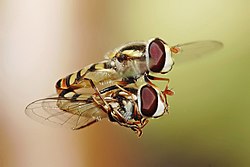| Simosyrphus grandicornis | |
|---|---|
 | |
| Scientific classification | |
| Kingdom: | Animalia |
| Phylum: | Arthropoda |
| Class: | Insecta |
| Order: | Diptera |
| Family: | Syrphidae |
| Genus: | Simosyrphus |
| Species: | S. grandicornis |
| Binomial name | |
| Simosyrphus grandicornis (Macquart, 1842) | |
| Synonyms | |
Simosyrphus grandicornis, commonly known as the yellow-shouldered stout hoverfly, is an Australasian species of hoverfly, and is one of the two most common hoverflies in Australia, alongside Melangyna viridiceps . [1] It has been introduced to a number of Polynesian Islands as well as Hawaii. [2]
Contents
Eggs are laid near aphid colonies, as the prey of this species' larvae is mainly aphids. [3]
